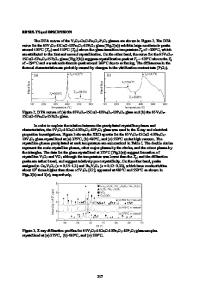Crystallization and dielectric properties of SrO-BaO-Nb 2 O 5 -GeO 2 tungsten-bronze glass-ceramics
- PDF / 444,183 Bytes
- 7 Pages / 612 x 792 pts (letter) Page_size
- 100 Downloads / 337 Views
llization and dielectric properties of SrO–BaO–Nb2O5–GeO2 glass–ceramics were investigated. One- and two-stage heat-treatment methods were used to convert the parent glass to glass–ceramics. Strontium barium niobate (SBN) with a tetragonal tungsten-bronze structure formed as the major crystalline phase. When the crystallizing temperature/time was increased, the secondary crystalline BaGe2O5 phase coexisted with SBN. BaGe2O5 formed as a surface layer grown from the surface into the interior of the sample. The dendritic morphology of SBN crystals was examined. The glass–ceramics crystallized by two-stage heat treatment have higher dielectric constants than those crystallized by one-stage heat treatment. The highest dielectric constant that was obtained in the present glass–ceramics was 320. The glass–ceramics showed relaxor-type dielectric behavior.
I. INTRODUCTION
Controlled crystallization in glasses has led to the development of glass–ceramic materials with pore-free, fine-grained microstructure and specific properties. Much of the work in the field of glass–ceramics has been done on the thermal and mechanical properties. On the other hand, few investigations were reported on the high-permittivity glass–ceramics containing a ferroelectric phase, such as BaTiO 3 , 1–3 PbTiO 3 , 4–7 LiTaO3,8 LiNbO3,9–11 NaNbO3,8,11–14 KNbO3,8,15 and (Pb, Sr, Ba)Nb2O6.16 The ferroelectric and dielectric properties are usually diluted by the glass former (e.g., SiO2, B2O3, etc.). However, the excellent composition and microstructure adjustability of glass–ceramics promises some advantages of high-permittivity glass– ceramics over the crystalline ferroelectric ceramics, e.g., adjustable thermal expansion, dielectric properties, and processing temperature. They also offer the process compatibility with ceramic substrates and metallized components.17,18 Therefore, high-permittivity glass–ceramic materials are candidates for capacitor, hybrid circuit, electrooptics, and cryogenic applications.17,18 Srx Ba1−x Nb2O6 (0.25 艋 x 艋 0.75) is a lead-free ferroelectric solid solution with the tetragonal tungstenbronze structure. It is particularly important in several applications such as pyroelectric detectors and electrooptic, piezoelectric, and surface acoustic wave devices.19 The Srx Ba1−x Nb2O6 materials have been fabricated through several techniques such as single-crystal growth by Czochralski’s method,19 sintering of polycrystalline ceramics,20,21 and deposition of thin or thick films.22 J. Mater. Res., Vol. 16, No. 7, Jul 2001
http://journals.cambridge.org
Downloaded: 27 Jan 2015
In our previous paper,23 we have reported on a 22.5SrO ⭈ 22.5BaO ⭈ 20Nb2O5 ⭈ 35SiO2 (mol%) glass– ceramic in which tungsten bronze Srx Ba1−x Nb2O6 crystal can be formed. In the present study, we will show that SrxBa1−xNb2O6 crystal can also be formed when GeO2 was used as the glass former. The dielectric properties of the resulting glass–ceramics were also investigated.
II. EXPERIMENTAL PROCEDURE A. Sample preparation
A glass with the composition 22.5 SrO, 2
Data Loading...











